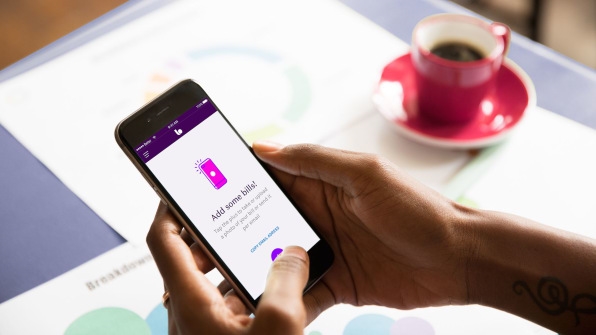What if filing your insurance claims was as easy as snapping a photo?
That’s precisely what Better, a new app for for filing out-of-network health insurance claims, professes to do. Launched in June, the startup promises just a few simple steps: Visit a doctor, pay the bill, take a photo of the gibberish that is your bill, then let Better handle the entire claim process—from start to finish.
In exchange, the debt relief app takes 10% of the money you get paid back. If it turns out the claim is not covered by your insurance or the amount is applied to your deductible, the service is free of charge.
In general, if you visit a doctor who does not accept your insurance, you have to pay out of pocket and then get a paper with a code on it that is then meant to be sent to the insurance company in hopes of recouping your money.
“But it’s such a complicated process, most people don’t get through it,” Better cofounder and CEO Rachael Norman tells Fast Company.
Instead, the bill is often shoved into a kitchen drawer because consumers don’t have the patience to oversee it. Or, if it is submitted, it’s often denied or returned due to incorrect or insufficient information.

Other times, it’s simply unclear if a certain treatment or claim is covered at all. “Members’ policies are written in intentionally ambiguous language,” says Norman. The full terms of a policy are traditionally hundreds of pages in length and sometimes only available by mail upon request. And while the Affordable Care Act expanded coverage to millions of previously uninsured Americans, it had little impact on affecting these kinds of insurance costs and inconveniences.
“Consumers are missing out on the full benefits on their insurance policy,” stresses Norman. She’s frustrated by what she sees as millions of dollars left on the table because of insurance companies’ failings, a complicated system by design. “Patients deserve to have someone on their side and should not be left without support in a system this complex,” wrote Norman on the Better company website.
Medical billing has quickly become a national crisis: One out of four American households struggle with medical debt, which is now the leading cause of personal bankruptcy, according to a survey by the Kauffman Family Foundation in conjunction with The New York Times. Meanwhile, Harvard Business Review estimates the nation spends $1 trillion dollars on health care administration each year.
“Your doctor’s office has trained professionals who do this day in, day out—working to make sure they get the money they’re owed from the insurance companies,” explains Norman. “They work really hard to do that. It’s not an easy system… and it’s something an individual, especially one with health issues, has trouble navigating on their own.”
Norman looked for a business—or really just any individual—who could help her decipher her own medical bills, which began piling up in her home.
“There was nothing out there,” she says, “so I built it.”

The Broken Medical System
Norman had always been interested in the medical field. She was pre-med at Stanford University and spent two summers doing HIV research at the National Institutes of Health. She even spent a year as a medical volunteer in Niger, Africa, assisting U.S. surgeons brought over by an NGO to offer free surgeries to impoverished communities. Ironically, the experience was precisely what led her to discontinue her studies.
“I saw just how broken the medical system is,” reflects Norman. The chief complaint among the doctors she worked with was that too many aspects of the system got in the way of providing the care they wanted for their patients. “I heard over and over again from doctors that they wouldn’t choose to do [this career] over again a second time.”
Related: How This Technology Is Making Doctors Hate Their Jobs
Instead, Norman decided to pursue a career in tech, with which, she holds, “you’re able to solve problems much more quickly.” She moved to San Francisco to work at Bitcoin startup 21 Inc., where she learned product development, engineering management, and the fundamentals of running a business.
In early 2016, Norman experienced an ‘aha’ moment that led her to want to strike out on her own–and revisit her interest in medicine. After spending countless hours on the phone attempting to resolve coding errors for out-of-network doctor appointment bills, she realized she had lost several thousand dollars over the years by simply giving up on the process. “I didn’t have the time,” she says, “it was such a headache.”
Then, a close friend got stuck with a $2 million medical bill following injuries from a house fire. The added burden of paying an unruly amount on top of managing one’s health inspired Norman to take action.
“It’s so stressful and horrible for people,” she says. “I wanted to find a way to help with this issue and do so in a way that could become a sustainable business and make an impact in this space.”
Norman threw herself into researching everything she could about the insurance billing system. While poking around the industry, she didn’t see anyone else providing a receipt submission service, “which was a really big motivator,” she says. Other medical bill apps exist, but most focus on bill negotiation or solving the issues that arise after claims are submitted. Norman wanted to build a system focused on the initial process, on what your insurance company hasn’t even handled yet.
Most of her days were filled with calling insurance companies, reaching out to lawyers, and immersing herself in the mind-boggling insurance code systems. For example, Norman learned that several big health insurance companies, such as Blue Shield, separate customers into two tiers. If you work for a major employer like Google or Facebook, you will be given preferential treatment, which includes a special corporate concierge service that handles calls and billing more efficiently. But if you work for a less prestigious company, you are routed to a different call center in which the agents are less than helpful.
At the latter, reports Norman, 20% of her calls were dropped. In addition, the insurance company repeatedly lost documents and files, asking her to re-send them via fax or mail. “Then their OCR (optical character recognition systems) for reading these claims are terrible,” Norman states.
“There’s So Much Work To Be Done”
In 2016, Norman met John Stockdale, a former engineer at Facebook who now serves as Better cofounder and CTO. Together they brought on a team of contractors, engineers, and angel investors, including Tim Trefren (cofounder of Mixpanel), Sean Plaice (cofounder of Postmates), and Brent Goldman (engineering manager at Uber). The company incorporated in March 2016.
They then built the product that would become Better and began testing it with a small circle. During an eight month-long beta mode, which started last summer, Better processed over $1.5 million worth of claims.
Now, a little after a year, Better is fully live, with seven full-time staff members. In lieu of Norman manually making calls, the product’s technology automatically sorts out all the insurance codes, thereby helping the company scale to a larger audience.
The company already has ambitious plans. For its first year, Better plans on dedicating 100% of its revenue to forgive $16 million of medical debt across America. (Medical debt often sells for pennies on the dollar, so this amounts to a little under $100,000.) The goal is to topple HBO’s Last Week Tonight host John Oliver, who forgave $15 million—the largest TV giveaway in history—as part of a public takedown of the debt-purchasing industry last June.
“He beat Oprah,” offers Norman of the TV giveaway, “and now we are going to beat him.”
While Better would not release specific numbers, the company reports it has already garnered “a lot of support” from health care providers, specifically solo practitioners such as therapists, dentists, and chiropractors. “They know [insurance claims are] something their patients struggle with,” says Norman.
Natalie Friedman is one such therapist who recommends Better to clients at her Los Angeles-based practice.
“Nine times out of 10, new clients come to me and our first conversation is not about their reason for seeking therapy but answering insurance questions,” writes Friedman. She says it ends up being a “fraught conversation” over insurance policies they do not understand. “People who are seeking therapy have already struggled to take the step to contact me (or any therapist), and then there’s this other hurdle to get over.”
A reportedly increasing amount of health care providers are opting out of insurance panels entirely because they find the extra billing work too exhausting. That then puts the entirety of the administrative burden on the consumer.
“The patient very commonly comes last,” sighs Norman. In coming years, she hopes to expand her business to new categories within the insurance claims sector. This includes bill negotiation, appeals, and access to resources. Because, as she sees it, the system will not dramatically change anytime soon.
“No matter what happens with health care [in politics], insurance companies will remain the same, and this particular problem is going to be there,” Norman predicts. Regardless which policy you choose, she says, you’re still buying “a black box” of ambiguous, confusing documents that even a lawyer would find taxing.
“[Health care] is a $3.3 trillion dollar industry—it moves very, very slowly,” she explains. “There are many thousand of players and anything that’s done to simplify it takes a very long time.” Beside, as Norman says, the complication serves in insurance companies favor: it minimizes the amount that they pay out in claims. “I don’t see the incentives aligning for it to get much easier for individuals anytime soon.”
Not that Norman is any way discouraged. If anything, she finds it motivating. The entrepreneur firmly believes technology is our best hope to change the health care system in the United States.
“There’s so much work to be done with exactly what we’re doing—getting people money back,” says Norman. “It’s such a huge problem. We’re going to stay focused on that.”
Better is a new app that simplifies the confusing, time-sucking process of filing out-of-network health insurance claims. Can it help Americans get their money back?
What if filing your insurance claims was as easy as snapping a photo?
Fast Company , Read Full Story
(25)